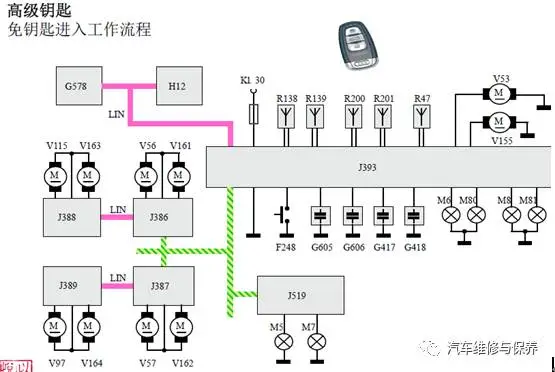Audi Q5 keyless entry unavailable
Wen/Zhongxin Zhibao Automobile Service Co., Ltd. Liu Jun Ren He Xin

Fault analysis and solutions
1. Verify faults:
First verify the fault, touch the left front door handle sensor, the vehicle can not unlock, the other three doors can not unlock, and can not lock normally. Remote control vehicles can be locked and unlocked normally.
II. Fault analysis:
Connect to ODIS to read fault storage, and the comfort system has no fault codes. Other systems are normal. Audi Q5 uses the fifth generation anti-theft system. The workflow is as follows:

When the driver touches the left front door handle sensor G605, the sensor sends the "entry" information to the comfort system central control unit J393 and reads the "entry" information, j393 sends the search key information to the key through R200 (left entry and start license antenna) and R201 (right entry and start license antenna). The key receives the information of R200 and R201, the key identification signal and anti-theft password information are sent to J393 through R47 (central door lock and anti-theft alarm device antenna), and the key information is received and verified by J393, after the verification is correct, the unlock signal is sent to the four-door door control unit through the comfort CAN line, and the vehicle is unlocked.
According to the above workflow analysis, remote unlocking and locking are normal, indicating that it is normal from R47 to J393 to four door control units and lock blocks, and keyless startup verification is also normal, note that from J393 to R200,R201,R138,R139, it is normal to find the key, and only four door handle sensors and J393 are left out. Through ODIS, the 46 comfort system reads the data flow of four door handle sensors. When operating four door handle sensors, none of the four door handle sensors can read the signal, the probability that the four door handle sensors are damaged at the same time is too small. The circuit between J393 and door handle sensors is preliminarily diagnosed. The ELSA circuit diagram, J393 power supply fuse, the black fuse holder SF8 SF10 SF11 in ST2 is normal, and the J393 ground iron, communication cable, is normal. The line between the door handle sensor and J393 is normal, and the diagnosis result is J393 fault, which needs to be replaced.
Since J393 did not have in stock, when verifying the fault again, it suddenly found that the car had a "drop" and "drop" tone during the process of locking and unlocking the car through remote control, and the original car had no tone, you can only turn on the hide function by swiping the hide function. It is suspected that when the car swiping the hide function, the code of J393 is changed out of order, and the keyless entry function is turned off. Communicate with customers through SA, the customer explained that he had hidden it before, and the keyless entry function was rarely used. He always used remote control to lock the car and unlock it. It is only found that it cannot be used once in a while. When communicating with customers, you need to re-encode. If not, you need to replace J393. With a try, through the online comparison of SVM, you can find that the current code is different from that of the original car. After the change, repeatedly operate the keyless entry function, no exception occurs, and the fault is relieved.
III. Maintenance plan:
J393 re-encoding
IV. Failure summary:
With the development of vehicles and the increase of many comfort functions, some car owners and friends often refit vehicles in order to pursue individuality, while the hidden function is the simplest refit without adding hardware, the hidden function is turned on only by changing the code of the control unit. Some modification personnel will change the code out of order because the equipment used does not match or the hidden data is incorrect, turning off some previous functions and causing some strange faults is a challenge for our maintenance personnel, which requires us to make solid basic skills and insist on learning new knowledge, so as to improve their own capabilities.